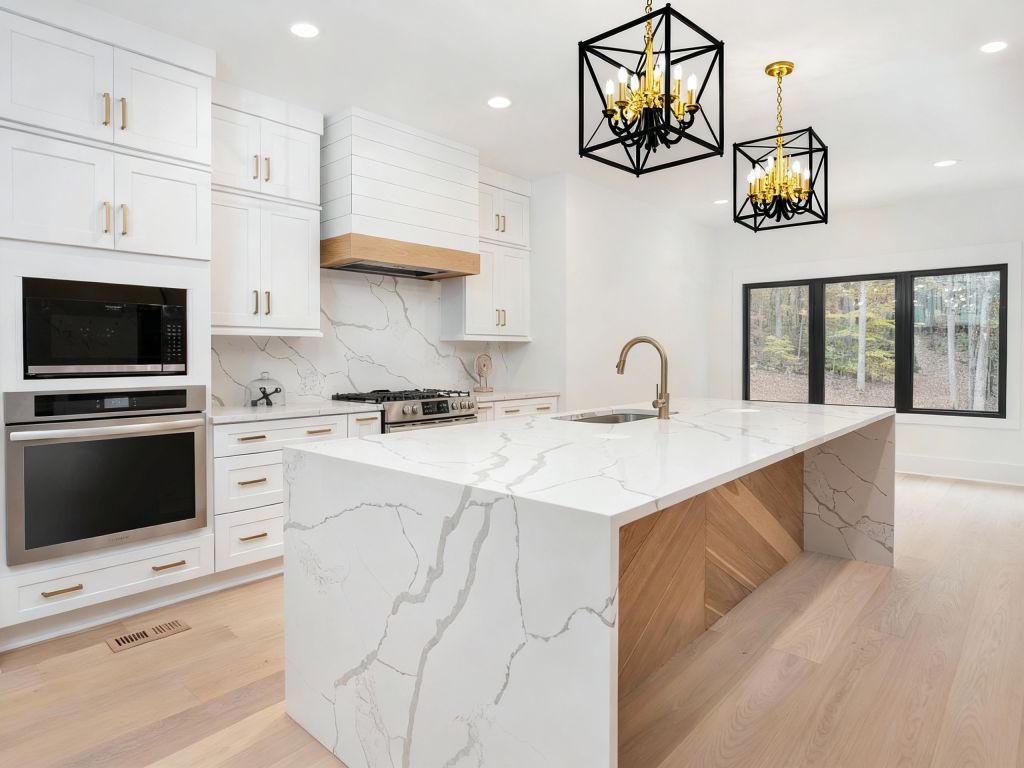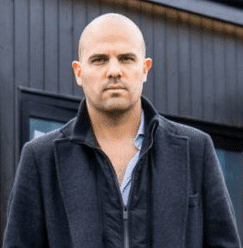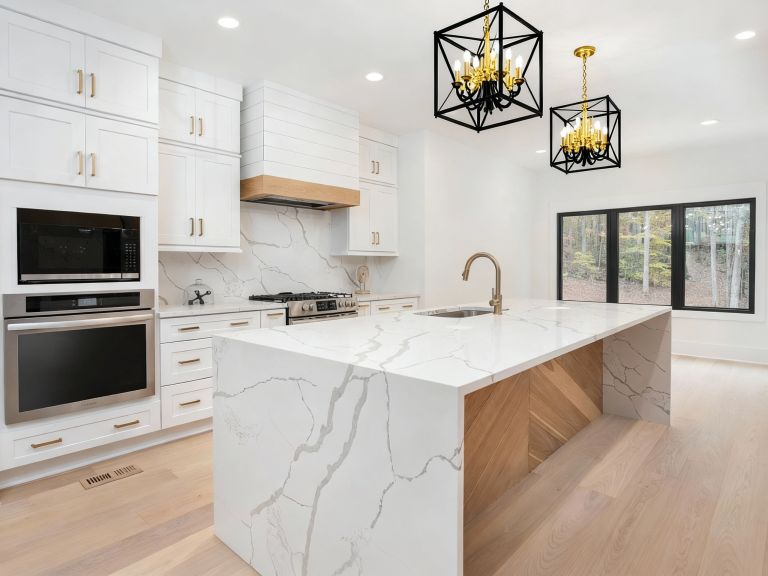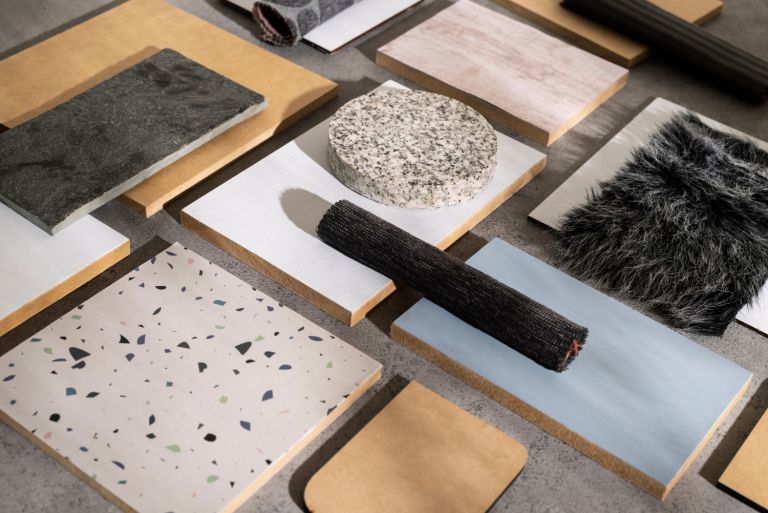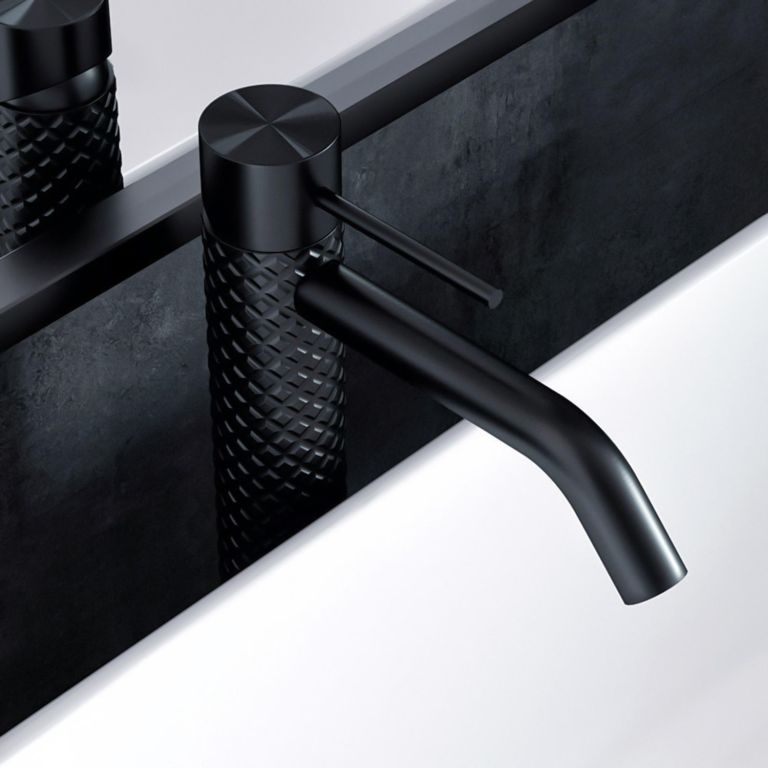The Waterfall Effect: Modern Luxury
Waterfall countertop islands have evolved from luxury home exclusives to mainstream design features. The continuous flow of countertop material cascading down one or both sides of an island creates visual drama that standard countertops cannot match.
At Greenberg Design Gallery, waterfall islands represent a growing portion of our kitchen designs. Clients love the contemporary aesthetic and seamless appearance. However, waterfall edges add significant cost and require careful planning. This guide covers everything you need to know about waterfall countertop islands.
What Makes a Waterfall Countertop
Standard Island Countertop
Traditional islands feature:
- Horizontal countertop surface
- Overhanging edge (typically 12″-15″)
- Visible cabinet sides below
- Standard edge treatment
Waterfall Countertop
Waterfall designs extend countertop material vertically:
- Countertop flows continuously down one or both sides
- Material covers island end panels completely
- Creates monolithic, sculptural appearance
- Conceals cabinet construction
- Emphasizes material’s beauty
Single vs. Double Waterfall
- Single waterfall: One end extends down (typically seating side)
- Double waterfall: Both ends extend down
- Partial waterfall: Extends partway down for outlet access or design variation
Cost Analysis
Material Cost Premiums
Waterfall edges require additional material and fabrication:
Quartz Waterfall (Most Popular)
- Standard island (8 ft x 4 ft): 3 slabs typical
- Waterfall island (same size): 4-5 slabs
- Additional material: 1-2 slabs x 400−400−800 = 400−400−1,600
- Fabrication premium: 800−800−1,500 per waterfall edge
- Total waterfall premium: 1,200−1,200−3,100
Granite Waterfall
- Material: Similar to quartz
- Fabrication more complex (natural material matching)
- Total waterfall premium: 1,500−1,500−3,500
Marble Waterfall
- Premium material cost
- Careful matching for continuous veining
- Total waterfall premium: 2,000−2,000−5,000+
Quartzite Waterfall
- Expensive base material
- Complex fabrication
- Total waterfall premium: 2,500−2,500−6,000+
Complete Island Cost Comparison
Standard 8 ft x 4 ft Island
- Quartz: 4,500−4,500−7,000 installed
- Granite: 5,000−5,000−9,000 installed
- Marble: 7,000−7,000−12,000 installed
Same Island with Single Waterfall
- Quartz: 5,700−5,700−10,100 installed
- Granite: 6,500−6,500−12,500 installed
- Marble: 9,000−9,000−17,000 installed
Same Island with Double Waterfall
- Quartz: 6,900−6,900−13,200 installed
- Granite: 8,000−8,000−16,000 installed
- Marble: 11,000−11,000−22,000 installed
Installation Complexity
Fabrication Challenges
Mitered Edges
- 45-degree miters where horizontal meets vertical
- Precision cutting required for seamless appearance
- Veining must align across miter (book-matching or flow-matching)
- Epoxy joints must be invisible
Weight Considerations
- Waterfall adds 200-400 pounds to island weight
- Requires structural support assessment
- Floor loading calculations for second-story installations
- Reinforced island construction necessary
Seam Placement
- Seams unavoidable on most waterfall islands
- Strategic placement minimizes visibility
- Quality fabrication makes seams nearly invisible
- Veining patterns help disguise seams
Installation Process
- Structural verification and reinforcement (if needed)
- Precise field measurements
- Material selection and slab review
- Fabrication with veining layout
- Dry-fit verification
- Final installation with specialized adhesives
- Seam filling and polishing
Installation timeline: 6-10 weeks from material selection to completion (vs. 3-5 weeks for standard countertops)
Material Selection for Waterfall Islands
Quartz: Most Popular Choice
Advantages
- Consistent patterns simplify matching
- Strong enough to support cantilever
- Manufactured in large slabs (fewer seams)
- Uniform appearance
- Easier fabrication than natural stone
Ideal Patterns
- Marble-look veining (Calacatta, Carrara patterns)
- Concrete-look for industrial kitchens
- Solid colors for minimalist designs
Cost Sweet Spot: 65−65−95 per square foot installed
Granite: Natural Beauty
Advantages
- Unique natural patterns
- Extremely durable
- Heat resistant
- Every island one-of-a-kind
Challenges
- Matching veining patterns difficult
- Seams more visible
- Color variation between slabs
Cost Range: 75−75−120 per square foot installed
Marble: Ultimate Luxury
Advantages
- Unmatched elegance and prestige
- Dramatic veining perfect for showcasing
- Timeless appeal
- Maximum visual impact
Challenges
- Softer stone (scratches and etches)
- Requires maintenance commitment
- Expensive
- Careful slab selection essential for continuous veining
Cost Range: 90−90−180+ per square foot installed
Quartzite: Durability Meets Beauty
Advantages
- Natural material with granite-like durability
- Often features marble-like veining
- Harder than marble
- Unique patterns
Challenges
- Expensive
- Limited availability
- Complex fabrication
- Variable quality (some sold as quartzite is actually softer stone)
Cost Range: 95−95−200+ per square foot installed
Design Considerations
When Waterfall Islands Work Best
Ideal Applications
- Modern and contemporary kitchens
- Open-concept layouts (island as focal point)
- Dramatic material patterns (veined marble, bold quartz)
- Larger islands (8 feet or longer)
- Seating on one end (waterfall on opposite end)
Less Ideal Situations
- Traditional or farmhouse kitchens (style mismatch)
- Very small islands (disproportionate impact)
- Busy material patterns (overwhelming)
- Tight budgets (standard edges deliver better value)
Visual Proportions
Island height affects waterfall success:
- Standard height (36″): Waterfall appropriate
- Raised bar height (42″): Waterfall impressive but expensive (longer vertical distance)
- Split-level islands: Waterfall on lower portion only usually works best
Outlet and Electrical Considerations
Challenge: Waterfall sides eliminate traditional outlet placement locations.
Solutions
Pop-Up Outlets
- Outlets emerge from countertop surface
- Hide when not in use
- Cost: 150−150−400 per outlet
- Maintain clean waterfall appearance
Toe-Kick Outlets
- Mounted in island base below waterfall
- Less convenient but unobtrusive
- Cost: 80−80−150 per outlet
- Standard installation
Integrated Strips
- Power strips built into island ends not covered by waterfall
- Functional but visible
- Cost: 60−60−120 per strip
Furniture-Style Legs
- Island stands on legs instead of full sides
- Allows side access for outlets
- Changes aesthetic (not true waterfall effect)
Plan electrical needs before finalizing waterfall design. Code requires outlets within 48″ of any island seating area.
Common Waterfall Mistakes
Pattern Mismatch
Veining that doesn’t flow naturally across miter looks amateurish. Quality fabricators carefully match patterns.
Wrong Material Selection
Busy patterns compete with waterfall drama. Simple or dramatically veined materials work best. Mid-range patterning often looks confused.
Proportional Issues
Waterfall on small islands (under 6 feet) can appear top-heavy. Reserve waterfall treatment for appropriately scaled islands.
Ignoring Toe-Kick
Waterfall panels need recessed toe-kick at floor level for comfortable standing. Flush-to-floor waterfalls create stubbed toes and cleaning challenges.
Outlet Afterthoughts
Planning outlets after waterfall fabrication creates compromises. Coordinate electrical and fabrication from the start.
Alternatives to Full Waterfall
Partial Waterfall
Extend material 12″-18″ down instead of full height:
- Reduced cost (less material)
- Still creates visual interest
- Allows conventional outlet placement below
- Good compromise solution
Contrasting Materials
Pair countertop material waterfall with different island base:
- Quartz waterfall on wood-paneled base
- Marble waterfall on painted cabinet base
- Creates multi-material interest
Mitered Edge Without Full Waterfall
Mitered horizontal edges create thickness illusion:
- Quartz appears as 3″ thick slab
- Provides substantial look
- Costs 30-40 percent less than waterfall
- Easier fabrication
Seating Integration
Waterfall + Overhang Combination
Common configuration:
- Waterfall on one end
- 15″ overhang on long side for seating
- Keeps waterfall visible and dramatic
- Provides functional seating area
Support Requirements
- Overhangs over 12″ require support
- Corbels, steel brackets, or posts
- Must support dynamic seating loads
- Building codes specify requirements
ROI and Resale Value
Value Impact
Luxury Markets (Palo Alto, Los Altos, Atherton)
- Waterfall islands expected in high-end renovations
- Absence may hurt perceived value
- Appropriate waterfall adds 60-80 percent of cost to value
Mid-Range Markets
- Waterfall nice but not expected
- Returns 40-60 percent of cost
- Better ROI on other upgrades
Value-Conscious Markets
- Waterfall may be over-improvement
- Standard islands sufficient
- Returns 30-50 percent of cost
Our Recommendation: Waterfall islands make sense when:
- Kitchen renovation budget exceeds $75,000
- Home value supports high-end finishes
- Open-concept layout showcases island
- Modern aesthetic guides design
Greenberg Design Gallery Waterfall Installations
Our recent waterfall island projects showcase possibilities:
Menlo Park Modern Kitchen
- Material: White Calacatta quartz
- Configuration: 10 ft island, double waterfall
- Cost premium: $3,800
- Result: Stunning focal point, seamless appearance
Los Altos Transitional Kitchen
- Material: Exotic quartzite
- Configuration: 9 ft island, single waterfall
- Cost premium: $4,200
- Result: Natural stone beauty displayed dramatically
Palo Alto Contemporary Kitchen
- Material: Concrete-look quartz
- Configuration: 12 ft island, single waterfall
- Cost premium: $2,900
- Result: Industrial elegance, consistent aesthetic
Visit our showroom to see waterfall installations and review material options suitable for this striking application.
Final Thoughts
Waterfall countertop islands make bold design statements in modern kitchens. They transform islands from functional work surfaces into sculptural focal points that showcase beautiful materials.
The premium costs and installation complexity require careful consideration. Success depends on appropriate material selection, skilled fabrication, and integration with overall kitchen design. When executed well, waterfall islands elevate kitchen aesthetics and create memorable design impact.
At Greenberg Design Gallery, we help Bay Area homeowners determine whether waterfall islands suit their kitchens, select appropriate materials, coordinate fabrication, and ensure flawless installation. Our experience with hundreds of waterfall projects provides the expertise needed for successful results.
Ready to explore waterfall countertop options? Visit Greenberg Design Gallery in Palo Alto to see material samples, discuss design possibilities, and plan your stunning kitchen island.


